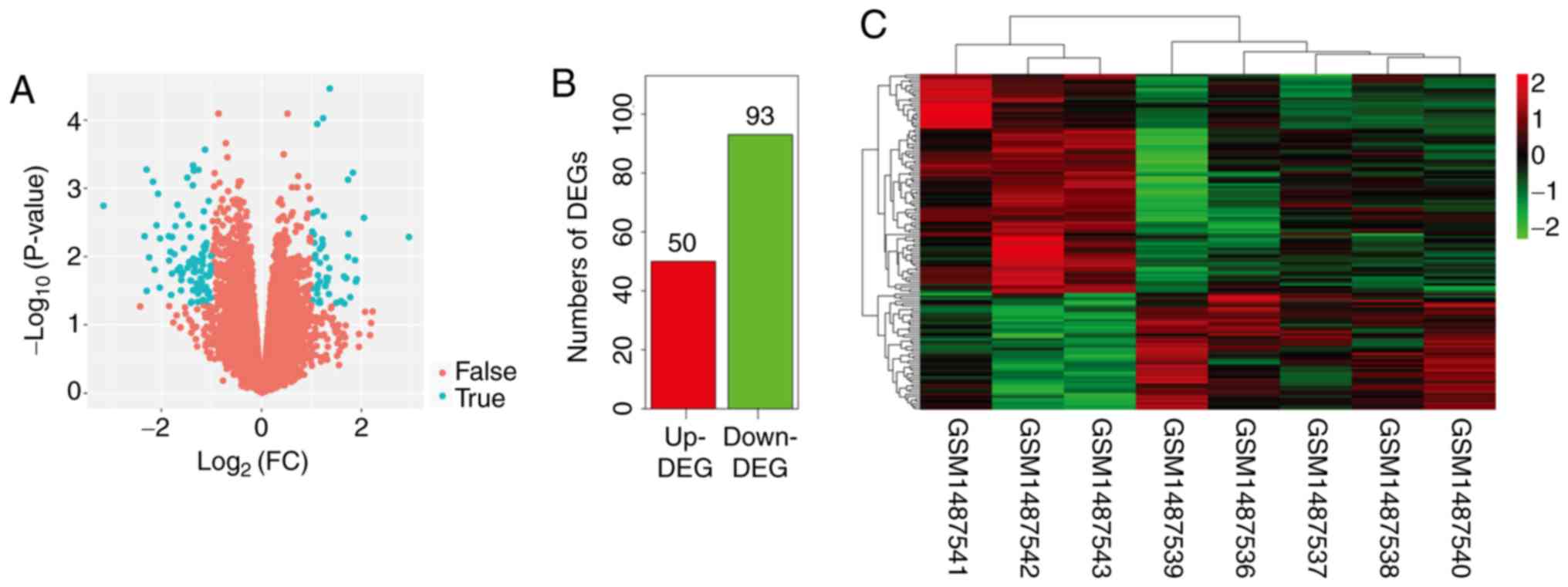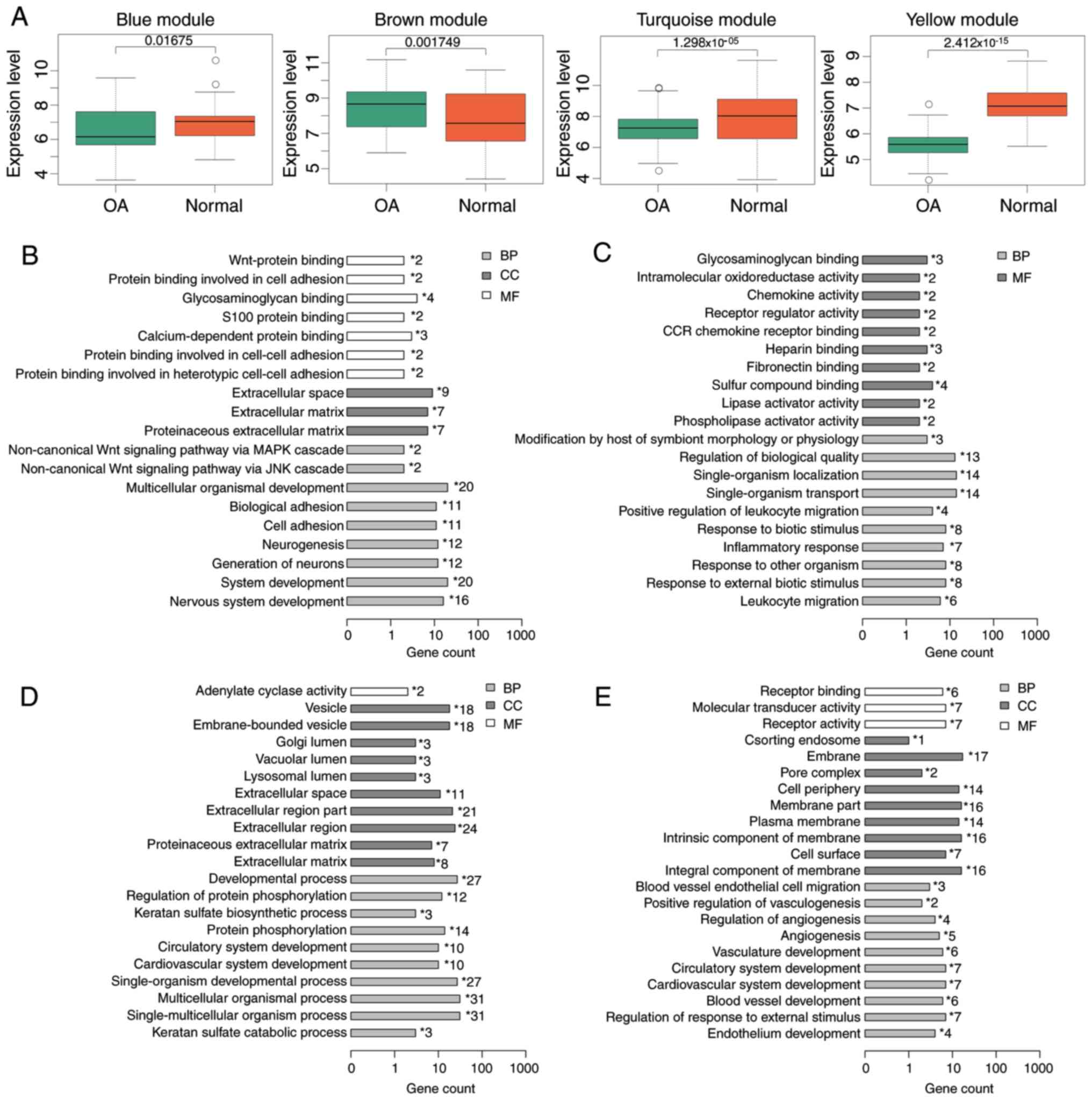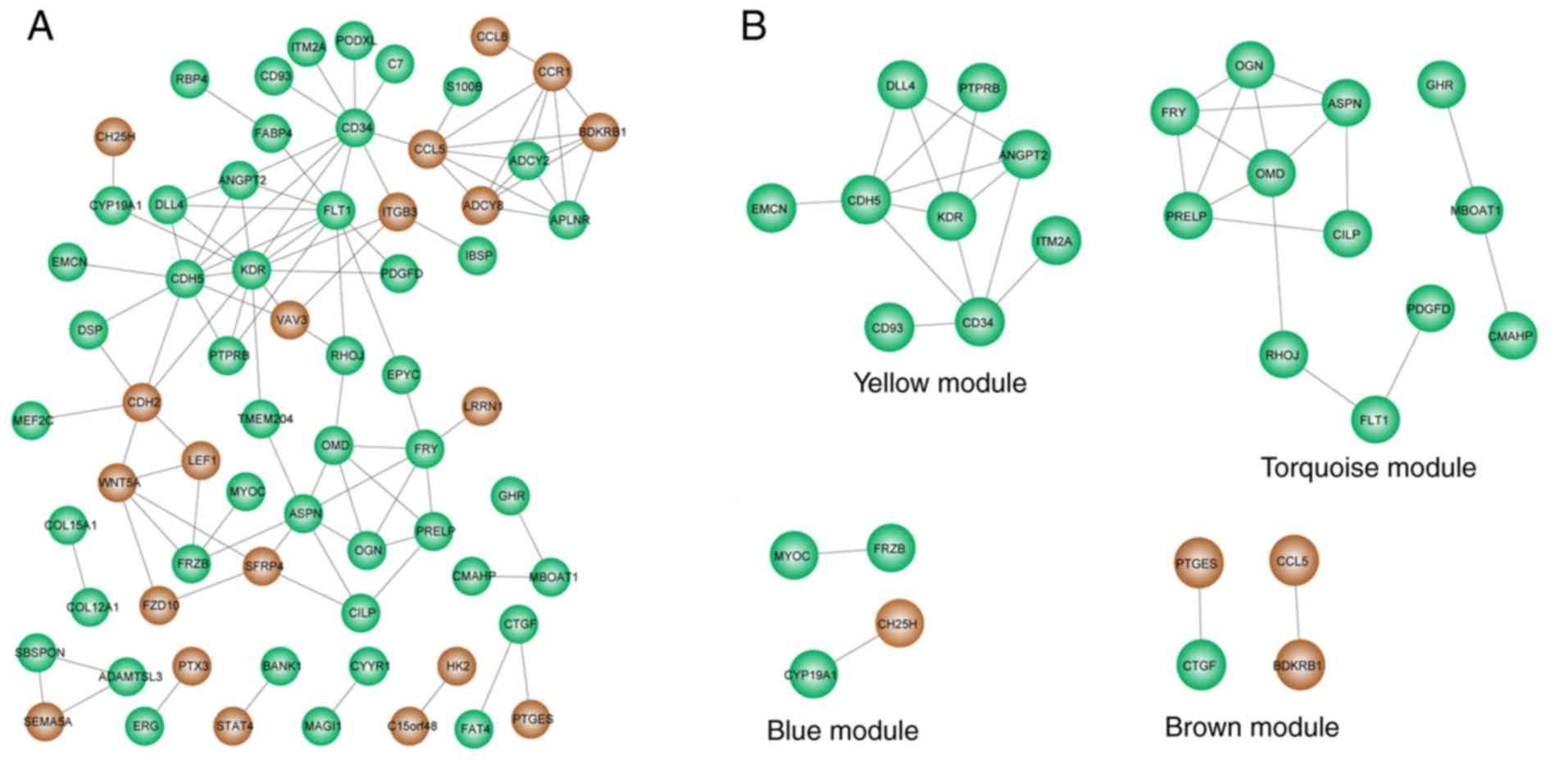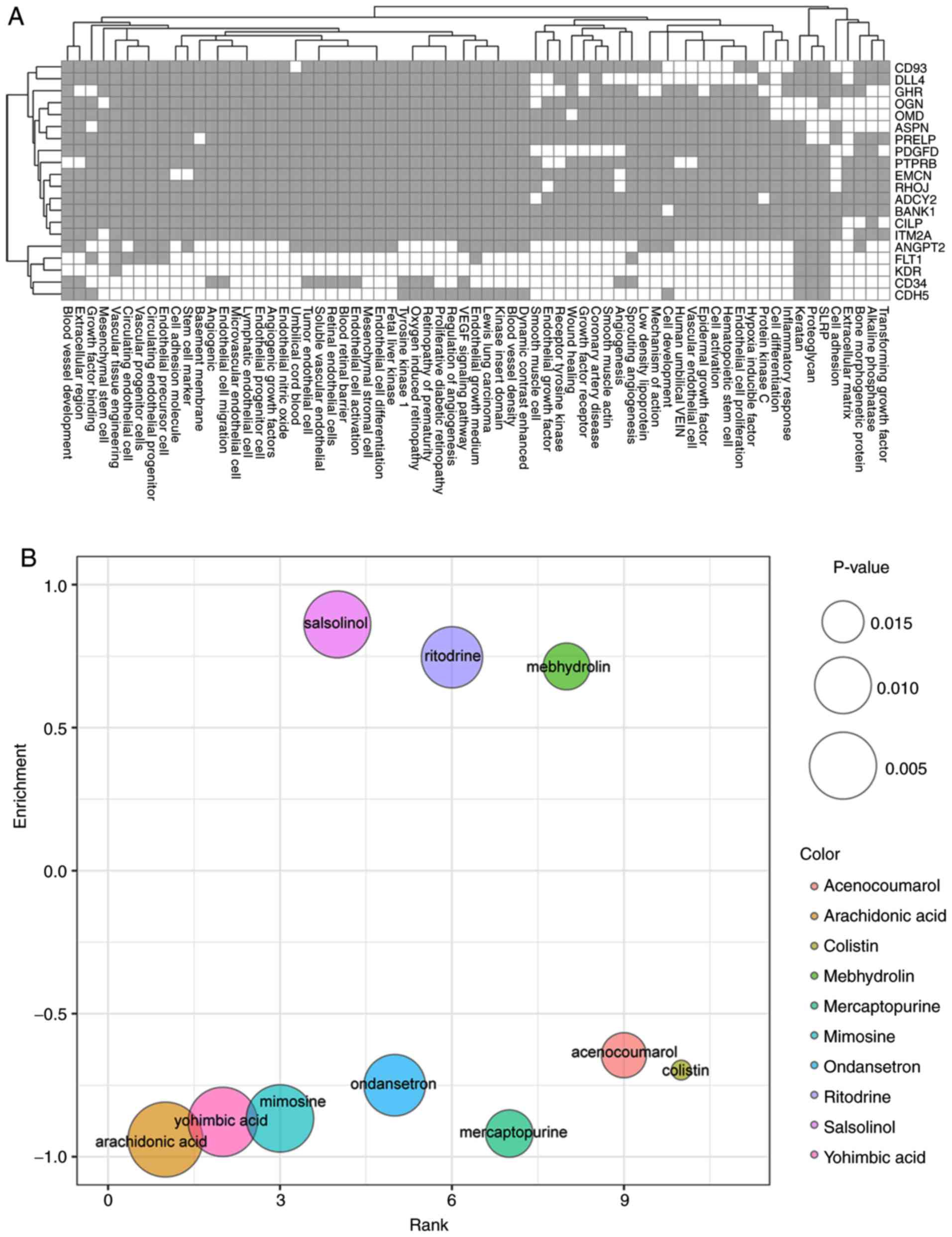|
1
|
Johnson VL and Hunter DJ: The epidemiology
of osteoarthritis. Best Pract Res Clin Rheumatol. 28:5–15. 2014.
View Article : Google Scholar : PubMed/NCBI
|
|
2
|
Madry H, Luyten FP and Facchini A:
Biological aspects of early osteoarthritis. Knee Surg Sports
Traumatol Arthrosc. 20:407–422. 2012. View Article : Google Scholar : PubMed/NCBI
|
|
3
|
Zhang Y, Jia J, Yang S, Liu X, Ye S and
Tian H: MicroRNA-21 controls the development of osteoarthritis by
targeting GDF-5 in chondrocytes. Exp Mol Med. 46:e792014.
View Article : Google Scholar : PubMed/NCBI
|
|
4
|
Meulenbelt I, Min JL, Bos S, Riyazi N,
Houwing-Duistermaat JJ, van der Wijk HJ, Kroon HM, Nakajima M,
Ikegawa S, Uitterlinden AG, et al: Identification of DIO2 as a new
susceptibility locus for symptomatic osteoarthritis. Hum Mol Genet.
17:1867–1875. 2008. View Article : Google Scholar : PubMed/NCBI
|
|
5
|
Bomer N, den Hollander W, Ramos YF, Bos
SD, van der Breggen R, Lakenberg N, Pepers BA, van Eeden AE,
Darvishan A, Tobi EW, et al: Underlying molecular mechanisms of
DIO2 susceptibility in symptomatic osteoarthritis. Ann Rheum Dis.
74:1571–1579. 2015. View Article : Google Scholar : PubMed/NCBI
|
|
6
|
Sharma AC, Srivastava RN, Srivastava SR,
Parmar D, Singh A and Raj S: Association between single nucleotide
polymorphisms of SMAD3 and BMP5 with the risk of knee
osteoarthritis. J Clin Diagn Res. 11:GC01–GC04. 2017.PubMed/NCBI
|
|
7
|
Ramos YF, den Hollander W, Bovée JV, Bomer
N, van der Breggen R, Lakenberg N, Keurentjes JC, Goeman JJ,
Slagboom PE, Nelissen RG, et al: Genes involved in the
osteoarthritis process identified through genome wide expression
analysis in articular cartilage; the RAAK study. PLoS One.
9:e1030562014. View Article : Google Scholar : PubMed/NCBI
|
|
8
|
Aigner T, Fundel K, Saas J, Gebhard PM,
Haag J, Weiss T, Zien A, Obermayr F, Zimmer R and Bartnik E:
Large-scale gene expression profiling reveals major pathogenetic
pathways of cartilage degeneration in osteoarthritis. Arthritis
Rheum. 54:3533–3544. 2006. View Article : Google Scholar : PubMed/NCBI
|
|
9
|
Szychlinska MA, Trovato FM, Di Rosa M,
Malaguarnera L, Puzzo L, Leonardi R, Castrogiovanni P and Musumeci
G: Co-expression and co-localization of cartilage glycoproteins
CHI3L1 and lubricin in osteoarthritic cartilage: Morphological,
immunohistochemical and gene expression profiles. Int J Mol Sci.
17:3592016. View Article : Google Scholar : PubMed/NCBI
|
|
10
|
Musumeci G, Mobasheri A, Trovato FM,
Szychlinska MA, Graziano AC, Lo Furno D, Avola R, Mangano S,
Giuffrida R and Cardile V: Biosynthesis of collagen I, II, RUNX2
and lubricin at different time points of chondrogenic
differentiation in a 3D in vitro model of human mesenchymal stem
cells derived from adipose tissue. Acta Histochem. 116:1407–1417.
2014. View Article : Google Scholar : PubMed/NCBI
|
|
11
|
Di Rosa M, Szychlinska MA, Tibullo D,
Malaguarnera L and Musumeci G: Expression of CHI3L1 and CHIT1 in
osteoarthritic rat cartilage model. A morphological study. Eur J
Histochem. 58:24232014. View Article : Google Scholar : PubMed/NCBI
|
|
12
|
Giunta S, Castorina A, Marzagalli R,
Szychlinska MA, Pichler K, Mobasheri A and Musumeci G: Ameliorative
effects of PACAP against cartilage degeneration. Morphological,
immunohistochemical and biochemical evidence from in vivo and in
vitro models of rat osteoarthritis. Int J Mol Sci. 16:5922–5944.
2015. View Article : Google Scholar : PubMed/NCBI
|
|
13
|
Wang B, Zhao J and Zhang P: Gene
signatures in osteoarthritic acetabular labrum using microarray
analysis. Int J Rheum Dis. 20:1927–1934. 2017. View Article : Google Scholar : PubMed/NCBI
|
|
14
|
Juchtmans N, Dhollander AA, Coudenys J,
Audenaert EA, Pattyn C, Lambrecht S and Elewaut D: Distinct
dysregulation of the small leucine-rich repeat protein family in
osteoarthritic acetabular labrum compared to articular cartilage.
Arthritis Rheumatol. 67:435–441. 2015. View Article : Google Scholar : PubMed/NCBI
|
|
15
|
Najafi A, Tavallaei M and Hosseini SM: A
systems biology approach for miRNA-mRNA expression patterns
analysis in non-small cell lung cancer. Cancer Biomark. 16:31–45.
2016. View Article : Google Scholar : PubMed/NCBI
|
|
16
|
Barrett T and Edgar R: Gene expression
omnibus: Microarray data storage, submission, retrieval, and
analysis. Methods Enzymol. 411:352–369. 2006. View Article : Google Scholar : PubMed/NCBI
|
|
17
|
Altman NS: An introduction to kernel and
nearest-neighbor nonparametric regression. Am Statistician.
46:175–185. 1992. View
Article : Google Scholar
|
|
18
|
Hastie T, Tibshirani R, Balasubramanian N
and Chu G: Impute: Imputation for microarray data. R package
version 1.42. 0. 2013.
|
|
19
|
Bolstad BM: preprocess Core: A collection
of pre-processing functions. R package version. 1:2013.
|
|
20
|
Smyth GK, Ritchie M, Thorne N and
Wettenhall J: LIMMA: Linear models for microarray data. In
bioinformatics and computational biology solutions using R and
bioconductor. Statistics for Biology and Health. 2005. View Article : Google Scholar
|
|
21
|
Langfelder P and Horvath S: WGCNA: An R
package for weighted correlation network analysis. BMC
Bioinformatics. 9:5592008. View Article : Google Scholar : PubMed/NCBI
|
|
22
|
Ashburner M, Ball CA, Blake JA, Botstein
D, Butler H, Cherry JM, Davis AP, Dolinski K, Dwight SS, Eppig JT,
et al: Gene Ontology: Tool for the unification of biology. The Gene
Ontology Consortium. Nat Genet. 25:25–29. 2000. View Article : Google Scholar : PubMed/NCBI
|
|
23
|
Yu G, Wang LG, Han Y and He QY:
clusterProfiler: An R package for comparing biological themes among
gene clusters. OMICS. 16:284–287. 2012. View Article : Google Scholar : PubMed/NCBI
|
|
24
|
von Mering C, Jensen LJ, Kuhn M, Chaffron
S, Doerks T, Krüger B, Snel B and Bork P: STRING 7-recent
developments in the integration and prediction of protein
interactions. Nucleic Acids Res 35 (Database Isuue). D358–D362.
2007. View Article : Google Scholar
|
|
25
|
Shannon P, Markiel A, Ozier O, Baliga NS,
Wang JT, Ramage D, Amin N, Schwikowski B and Ideker T: Cytoscape: A
software environment for integrated models of biomolecular
interaction networks. Genome Res. 13:2498–2504. 2003. View Article : Google Scholar : PubMed/NCBI
|
|
26
|
Wang JH, Zhao LF, Lin P, Su XR, Chen SJ,
Huang LQ, Wang HF, Zhang H, Hu ZF, Yao KT and Huang ZX: GenCLiP
2.0: A web server for functional clustering of genes and
construction of molecular networks based on free terms.
Bioinformatics. 30:2534–2536. 2014. View Article : Google Scholar : PubMed/NCBI
|
|
27
|
Lamb J, Crawford ED, Peck D, Modell JW,
Blat IC, Wrobel MJ, Lerner J, Brunet JP, Subramanian A, Ross KN, et
al: The Connectivity Map: Using gene-expression signatures to
connect small molecules, genes, and disease. Science.
313:1929–1935. 2006. View Article : Google Scholar : PubMed/NCBI
|
|
28
|
Ferrara N, Gerber HP and LeCouter J: The
biology of VEGF and its receptors. Nat Med. 9:669–676. 2003.
View Article : Google Scholar : PubMed/NCBI
|
|
29
|
Pesesse L, Sanchez C and Henrotin Y:
Osteochondral plate angiogenesis: A new treatment target in
osteoarthritis. Joint Bone Spine. 78:144–149. 2011. View Article : Google Scholar : PubMed/NCBI
|
|
30
|
Mayr-Wohlfart U, Waltenberger J, Hausser
H, Kessler S, Günther KP, Dehio C, Puhl W and Brenner RE: Vascular
endothelial growth factor stimulates chemotactic migration of
primary human osteoblasts. Bone. 30:472–477. 2002. View Article : Google Scholar : PubMed/NCBI
|
|
31
|
Deckers MM, Karperien M, Van der Bent C,
Yamashita T, Papapoulos SE and Löwik CW: Expression of vascular
endothelial growth factors and their receptors during osteoblast
differentiation. Endocrinology. 141:1667–1674. 2000. View Article : Google Scholar : PubMed/NCBI
|
|
32
|
Hopwood B, Gronthos S, Kuliwaba JS, Robey
PG, Findlay DM and Fazzalari NL: Identification of differentially
expressed genes between osteoarthritic and normal trabecular bone
from the intertrochanteric region of the proximal femur using cDNA
microarray analysis. Bone. 36:635–644. 2005. View Article : Google Scholar : PubMed/NCBI
|
|
33
|
Gao Y, Lu N, Ling Y, Chen Y, Wang L, Zhao
Q, Qi Q, Liu W, Zhang H, You Q and Guo Q: Oroxylin A inhibits
angiogenesis through blocking vascular endothelial growth
factor-induced KDR/Flk-1 phosphorylation. J Cancer Res Clin Oncol.
136:667–675. 2010. View Article : Google Scholar : PubMed/NCBI
|
|
34
|
Kwak HJ, Park MJ, Park CM, Moon SI, Yoo
DH, Lee HC, Lee SH, Kim MS, Lee HW, Shin WS, et al: Emodin inhibits
vascular endothelial growth factor-A-induced angiogenesis by
blocking receptor-2 (KDR/Flk-1) phosphorylation. Int J Cancer.
118:2711–2720. 2010. View Article : Google Scholar
|
|
35
|
Haywood L, Mcwilliams DF, Pearson CI, Gill
SE, Ganesan A, Wilson D and Walsh DA: Inflammation and angiogenesis
in osteoarthritis. Arthritis Rheum. 48:2173–2177. 2003. View Article : Google Scholar : PubMed/NCBI
|
|
36
|
Mifune Y, Matsumoto T, Takayama K, Ota S,
Li H, Meszaros LB, Usas A, Nagamune K, Gharaibeh B, Fu FH and Huard
J: The effect of platelet-rich plasma on the regenerative therapy
of muscle derived stem cells for articular cartilage repair.
Osteoarthritis Cartilage. 21:175–185. 2013. View Article : Google Scholar : PubMed/NCBI
|
|
37
|
Mao XG, Xue XY, Wang L, Zhang X, Yan M, Tu
YY, Lin W, Jiang XF, Ren HG, Zhang W and Song SJ: CDH5 is
specifically activated in glioblastoma stemlike cells and
contributes to vasculogenic mimicry induced by hypoxia. Neuro
Oncol. 15:865–879. 2013. View Article : Google Scholar : PubMed/NCBI
|
|
38
|
Abraham S, Yeo M, Montero-Balaguer M,
Paterson H, Dejana E, Marshall CJ and Mavria G:
VE-Cadherin-mediated cell-cell interaction suppresses sprouting via
signaling to MLC2 phosphorylation. Curr Biol. 19:668–674. 2009.
View Article : Google Scholar : PubMed/NCBI
|
|
39
|
Strassburger M, Bloch W, Sulyok S,
Schüller J, Keist AF, Schmidt A, Wenk J, Peters T, Wlaschek M,
Lenart J, et al: Heterozygous deficiency of manganese superoxide
dismutase results in severe lipid peroxidation and spontaneous
apoptosis in murine myocardium in vivo. Free Radic Biol Med.
38:1458–1470. 2005. View Article : Google Scholar : PubMed/NCBI
|
|
40
|
Sidney LE, Branch MJ, Dunphy SE, Dua HS
and Hopkinson A: Concise review: Evidence for CD34 as a common
marker for diverse progenitors. Stem cells. 32:1380–1389. 2014.
View Article : Google Scholar : PubMed/NCBI
|
|
41
|
Kamato D, Burch ML, Piva TJ, Rezaei HB,
Rostam MA, Xu S, Zheng W, Little PJ and Osman N: Transforming
growth factor-β signalling: Role and consequences of Smad linker
region phosphorylation. Cell Signal. 25:2017–2024. 2013. View Article : Google Scholar : PubMed/NCBI
|
|
42
|
Grafe I, Yang T, Alexander S, Homan EP,
Lietman C, Jiang MM, Bertin T, Munivez E, Chen Y, Dawson B, et al:
Excessive transforming growth factor-beta signaling is a common
mechanism in osteogenesis imperfecta. Nat Med. 20:670–675. 2014.
View Article : Google Scholar : PubMed/NCBI
|
|
43
|
Blaney Davidson EN, van der Kraan PM and
van den Berg WB: TGF-beta and osteoarthritis. Osteoarthritis
Cartilage. 15:597–604. 2007. View Article : Google Scholar : PubMed/NCBI
|
|
44
|
Kuroda R, Usas A, Kubo S, Corsi K, Peng H,
Rose T, Cummins J, Fu FH and Huard J: Cartilage repair using bone
morphogenetic protein 4 and muscle-derived stem cells. Arthritis
Rheum. 54:433–442. 2006. View Article : Google Scholar : PubMed/NCBI
|
|
45
|
Hessle L, Johnson KA, Anderson HC,
Narisawa S, Sali A, Goding JW, Terkeltaub R and Millan JL:
Tissue-nonspecific alkaline phosphatase and plasma cell membrane
glycoprotein-1 are central antagonistic regulators of bone
mineralization. Proc Natl Acad Sci USA. 99:9445–9449. 2002.
View Article : Google Scholar : PubMed/NCBI
|
|
46
|
Addison WN, Azari F, Sørensen ES,
Kaartinen MT and McKee MD: Pyrophosphate inhibits mineralization of
osteoblast cultures by binding to mineral, up-regulating
osteopontin, and inhibiting alkaline phosphatase activity. J Biol
Chem. 282:15872–15883. 2007. View Article : Google Scholar : PubMed/NCBI
|
|
47
|
Berenbaum F: Osteoarthritis as an
inflammatory disease (osteoarthritis is not osteoarthrosis!).
Osteoarthritis Cartilage. 21:16–21. 2013. View Article : Google Scholar : PubMed/NCBI
|
|
48
|
Goldring MB and Otero M: Inflammation in
osteoarthritis. Curr Opin Rheumatol. 23:471–478. 2011. View Article : Google Scholar : PubMed/NCBI
|
|
49
|
Melgarejo E, Medina MA, Sánchez-Jiménez F
and Urdiales JL: Monocyte chemoattractant protein-1: A key mediator
in inflammatory processes. Int J Biochem Cell Biol. 41:998–1001.
2009. View Article : Google Scholar : PubMed/NCBI
|
|
50
|
Kuehl FA Jr and Egan RW: Prostaglandins,
arachidonic acid, and inflammation. Science. 210:978–984. 1980.
View Article : Google Scholar : PubMed/NCBI
|
|
51
|
Pillinger MH, Marjanovic N, Kim SY, Scher
JU, Izmirly P, Tolani S, Dinsell V, Lee YC, Blaser MJ and Abramson
SB: Matrix metalloproteinase secretion by gastric epithelial cells
is regulated by E prostaglandins and MAPKs. J Biol Chem.
280:9973–9979. 2005. View Article : Google Scholar : PubMed/NCBI
|


















